BedZED
| BedZED | |
|---|---|
|
BedZED Ecovillage | |
| Location | Hackbridge, London Borough of Sutton |
| Coordinates | 51°22′55.5″N 00°09′21.67″W / 51.382083°N 0.1560194°WCoordinates: 51°22′55.5″N 00°09′21.67″W / 51.382083°N 0.1560194°W |
| Status | Environmentally friendly housing development |
| Constructed | 2000-2002 |
| Governing Body | Peabody Trust |

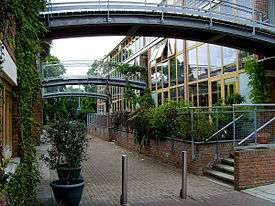
Beddington Zero Energy Development (BedZED) environmentally friendly housing development in Hackbridge, London, England. It is in the London Borough of Sutton, 2.0 miles (3 km) north-east of the town of Sutton itself. Designed to create zero carbon emissions, it was the first large scale community to do so.[1]
Background
BedZED was designed by the architect Bill Dunster to be carbon neutral, protecting the environment[1] and supporting a more sustainable lifestyle. The project was led by the Peabody Trust in partnership with Bill Dunster Architects, Ellis & Moore Consulting Engineers, BioRegional, Arup and the cost consultants Gardiner and Theobald. The project was also pioneering by being the first construction project where a local authority sold land at below market value to make sustainable economically development viable.[1]
The 82 homes, and 1,405 square metres (15,120 sq ft) of work space were built in 2000–2002. The project was shortlisted for the Stirling Prize in 2003.
Transport
Because of BedZED's low-energy-emission concept, cars are discouraged; the project encourages public transport, cycling and walking, and has limited parking space. There are good rail and bus links in the immediate area. They also have a car-share scheme.
Principles
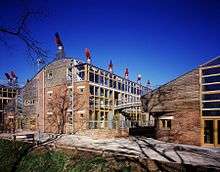
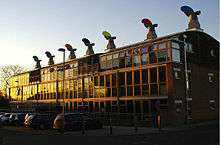
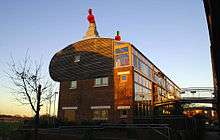
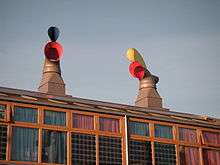
- Zero energy—The project is designed to use only energy from renewable sources generated on site. There are 777 square metres (8,360 sq ft) of solar panels. Tree waste fuels the development's cogeneration plant (downdraft gasifier) to provide district heating and electricity. The gasifier is not being used, because of technical implementation problems, though the technology has been and is being used successfully at other sites.
- High quality—The apartments are finished to a high standard to attract the urban professional.
- Energy efficient—The houses face south to take advantage of solar gain, are triple glazed, and have high thermal insulation.
- Water efficient—Most rain water falling on the site is collected and reused. Appliances are chosen to be water-efficient and use recycled water when possible. A "living machine" system of recycling waste water was installed, but is not operating.
- Low-impact materials—Building materials were selected from renewable or recycled sources within 50 miles (80 km) of the site, to minimize the energy required for transportation.
- Waste recycling—Refuse-collection facilities are designed to support recycling.
- Transport—The development works in partnership with the United Kingdom's leading car-sharing operator, City Car Club. Residents are encouraged to use this environmentally friendly alternative to car ownership; an on-site selection of vehicles are available for use.
- Encourage eco-friendly transport—Electric and liquefied-petroleum-gas cars have priority over cars that burn petrol and diesel, and electricity is provided in parking spaces for charging electric cars.
- A higher reported quality of life, with a strong sense of community
Performance
Monitoring conducted in 2003[2] found that BedZED had achieved these reductions in comparison to UK averages:
- Space-heating requirements were 88% less.
- Hot-water consumption was 57% less.
- The electrical power used, at 3 kilowatt hours per person per day, was 25% less than the UK average; 11% of this was produced by solar panels.[3] The remainder normally would be produced by a combined-heat-and-power plant fuelled by wood chips, but the installation company's financial problems have delayed use of the plant.
- Mains-water consumption has been reduced by 50%, or 67% compared to a power-shower household.
- The residents' car mileage is 65% less.
Problems
A review of the BedZed development in 2010[4] drew mainly positive conclusions. Residents and neighbours were largely happy. However, a few significant failures were highlighted, for example:
- The biomass wood chip boiler (biomass gasifier) was no longer in operation and the backup power source, a gas boiler, was now used.[4] The downdraft wood chip gasifier CHP (combined heat and power) had reliability problems due to technical problems and the intermittent schedule of operation (no late-night operation) imposed by the local authority.[5]
- The 'Living Machine' water recycling facility had been unable to clean the water sufficiently. The cost of the facility also made it unviable.[4]
- Passive heating from the sunspaces had been insufficient.
- Despite best efforts, residents were on average still leaving an ecological footprint of 1.7 planets, which is more than the target of 1.0 planet (but much less than the UK average of 3 planets).[4]
Awards
- 2001 - Housing Design Award for sustainability, from the Royal Institute of British Architects
- 2001 - Evening Standard New Homes Awards – BedZED won the London Lifestyle award. "Ambitious and brave, and a model for future developments"
- 2001 - UK Solar Awards, run by Energy 21, for BedZED – "perhaps the most influential of all housing projects this century".
- 2002 - World Habitat Awards – BedZED was a finalist.
- 2003 - Office of the Deputy Prime Minister Award for sustainable communities – BedZED was short listed with 3 other projects.
- 2003 - Stirling Prize – BedZED was short listed
- 2003 - RIBA journal sustainability award - the judges said "BedZED goes way beyond the standard environmental checklist by challenging both the way we live and work... Until now, pioneering communities have often been attained at the expense of architectural ambition but at BedZED the architects have been highly innovative." [6]
- 2003 - Housing Design Awards – BedZED won a 'Completed Scheme' award.
- 2003 - Ashden Awards - for projects building on the experience of BedZED[7]
- 2002 - Energy Globe Award – international award recognising BedZED as the foremost example of sustainable energy in building and housing.
- 2002 - Building Services Award for innovation.
- 2004 - Bremen Awards Special Commendation
- 2004 - Civic Trust’s sustainability award
- 2005 - Sutton and Cheam Society Design award.
See also
References
- 1 2 3 Hyde, Richard; Watson, Steve; Cheshire, Wendy; Thompson, Mark (2007), The Environmental Brief: Pathways for Green Design, Taylor and Francis, p. 44, ISBN 978-0-203-96681-5
- ↑ Nicole Lazarus (October 2003). "Beddington Zero (Fossil) Energy Development: Toolkit for Carbon Neutral Developments - Part II". BioRegional.
- ↑ Simon Corbey (December 2005). "The BedZED lessons". University of East London.
- 1 2 3 4 Kucharek, Jan-Carlos (23 July 2010). "Bedding in nicely: BedZed was the ultimate sustainability trailblazer. Nearly a decade on, it may be thriving but it remains an anomaly". BD Reviews: Sustainability (supplement to Building Design).
- ↑ "BedZED seven years on" (PDF). Bioregional.com. July 2014. pp. 21–22. Retrieved 2015-08-10.
- ↑ "RIBA Journal Sustainability Award BedZED, Wallington, Surrey". Architects' Journal. 27 November 2003. Retrieved 17 November 2014.
- ↑ BedZED wins Ashden Award
External links
| Wikimedia Commons has media related to BedZED. |
- ZedFactory's BedZED website
- Bioregional BedZED website
- An architect’s sustainable dreams - chinadialogue article about BedZED
- Information about BedZED on Peabody's website
